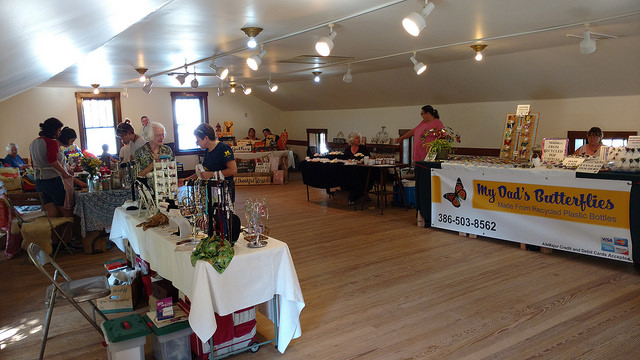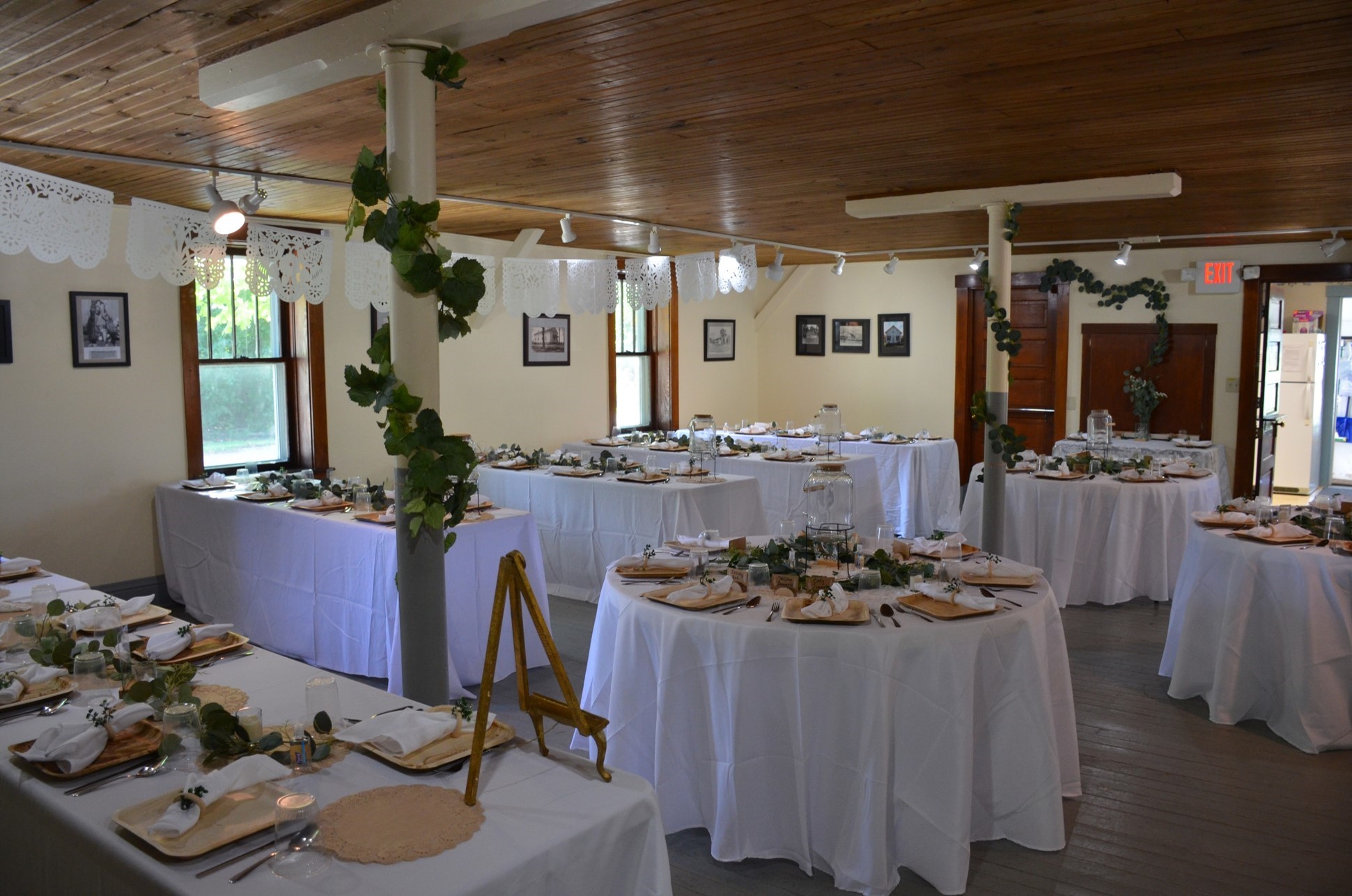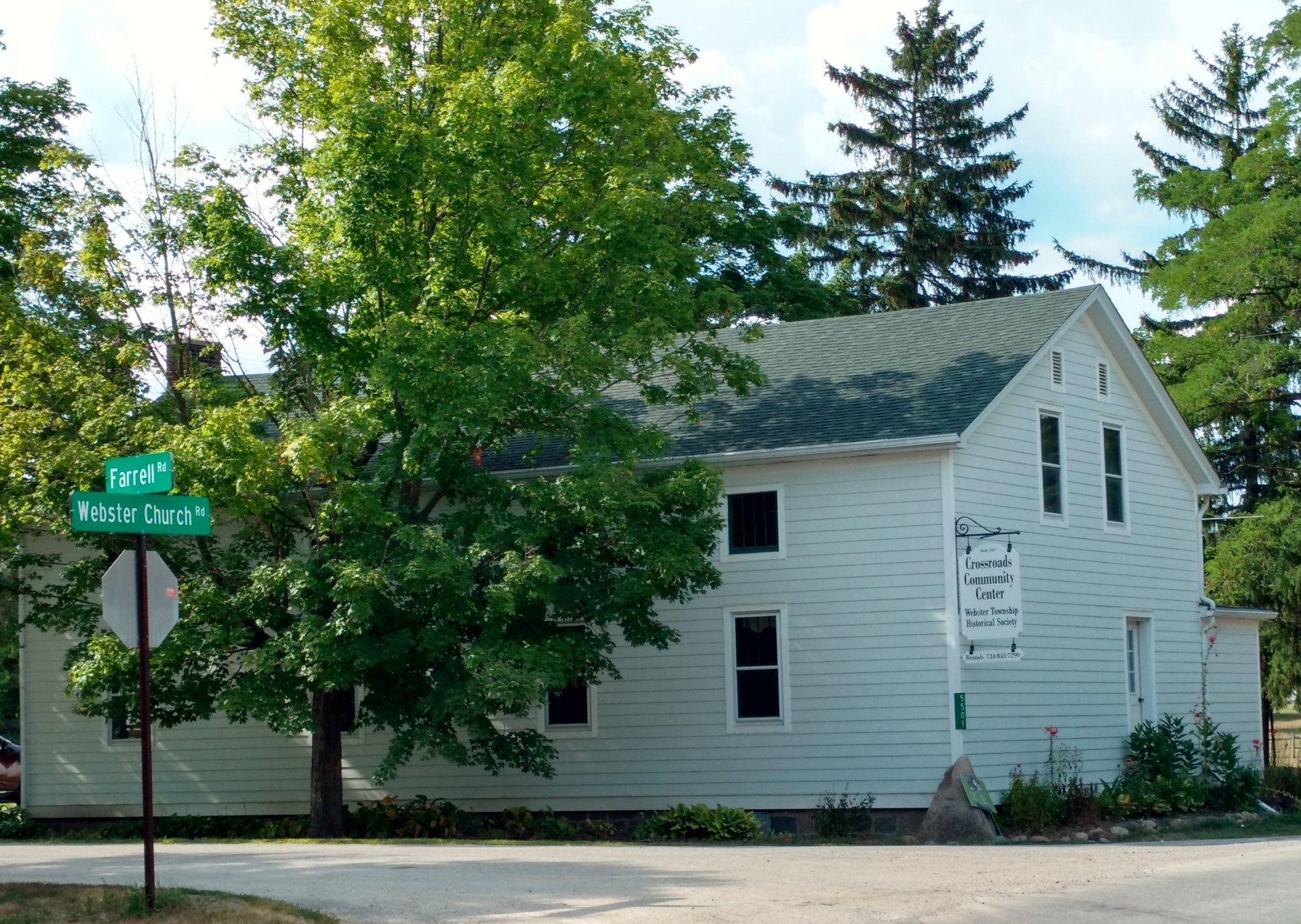
The first floor of this building has an open space to comfortably seat 64 banquet style or 75 theater style, a warming/serving kitchen, two bathrooms, and an entrance hall with an area for hanging coats. Today the Crossroads Community Center is a wonderful venue for classes of all kinds, club meetings, birthday parties, bridal or baby showers, graduation parties, wedding receptions, craft shows, farmers’ markets, and more. Contact WTHS (wthsmi@gmail.com) for rental information.



Where It Began. Across Farrell Road behind the one-room Webster School, stood a cider mill for grinding apples into mash and then pressing the cloth-layered mash to squeeze out cider. The grinder and press were powered with a horse harnessed to a turnstile. John W. Williams built a barn on his farm some time prior to 1867 as storage for the cider. The foundation had 18” thick walls of split field stone and mortar and an earthen floor for cold storage. The barn was a 1 ½ story structure framed with hand-hewn timber pinned with oak trunnels, or treenails. The exterior was clad with 13” rough-sawn vertical boards and painted red. The roof was composed of sawn wooden shingles. A set of double doors marked the entrance on the south side.
The mill sitting at a higher elevation than the storage barn allowed cider to be piped across Farrell Road to large wooden vats in the barn. After settling, cooling and aging, the cider was put into wood barrels and carted to the train depot at Delhi. From here, cider, wine and vinegar were shipped by rail to various parts of the country.

In September 1888, a notice in the Dexter Leader observed that Mr. Williams went to the Michigan State fair with his wine and cider filter. John Williams had many recipes for making different kinds of cider–he was the author of most of them. Many times he was offered large sums of money for his recipes, but he would not sell any of them. He said he made “men’s cider, women’s cider and cider for small boys. Some of his brands of cider were almost like champagne. (J. B. Parker & O. O. Williams, 2008. The Third Marked Tree: Paths through the Wilderness–John Williams of Webster Township and His Descendants. Smith Falls, ON, Canada: Performance Printing.) Mr. Williams ran his cider operation from 1867 until around 1917—both the mill and the storage barn were no longer in use by 1918. The mill was razed in 1939.
Because non-bible-based activity in the church was considered blasphemous, the Webster community needed a meeting place other than the church for secular activity. However, an organization other than the township government needed to take ownership and attend to the conversion and long-term care of such a facility. Furthermore, the only organization in the township that could provide such oversight was the Webster Congregational Church.
Ralph and Nellie Williams were willing to donate their unused cider storage barn for conversion to a community meeting house. So, the building and one-half acre of land was purchased on March 27, 1925 by the First Congregational Church Association of Webster for $1.00 from Mr. and Mrs. Williams. Horace Whitney and Frank Kleinschmidt took responsibility for raising funds from throughout the community and rounding up volunteer workers to convert the storage shed into a community meeting house. The south side of the barn was closed in, windows were installed, a chimney built, a furnace installed, a kitchen installed, asphalt shingles covered the wood shingles, a new entrance and porch faced Webster Church Road, the vertical siding was replaced with clapboard siding and it was painted white. The building became known as “The Webster Community House.”

It was the largest meeting hall in Webster Township and served as the social hub of the community for nearly 85 years. The Webster Church annual Homecoming celebration always included a big meal in the Community House. More than 200 people celebrated the hundredth anniversary of the township’s founding with dinner in the Community House! During WWII, Red Cross classes on rolling bandages and making beds were held in the Community House. The second-floor “theater-with-stage” served as the “inner sanctum” of the secretive Farmers Grange. From 1932 to 1985, weddings, showers, parties, fund-raisers—chicken dinners, fish suppers, oyster suppers, and strawberry socials—talent shows, dances, PTA and Farm Bureau meetings, Red Cross projects, and local 4-H club meetings kept the building alive.

In the 1950s a north side addition was put in place for indoor toilets. There already was a door located such that it would open into the new addition. In the 1960s Webster Church Road was widened and paved. The old elm tree which stood in the middle of the road—people drove around it for many years—at Webster corners was removed as well as the oak trees that lined the road. At this time, a second addition was erected on the north side to accommodate a new entrance.
In 1960, a new roof, ceiling, and light fixtures were installed. In 1964, the bathrooms and a side porch were added (the front porch was now too close to the road to continue using). During the 1960s, a shed was added to the west side for storage and service entry. In 1974, May Mast gifted shutters for the building which were later removed. In 1984 the Church Guild gifted a commercial stove for the hall. In 1995, the second floor was substantially renovated and a new gas furnace, electrical wiring, water heater, and water softener were installed. The foundation was tuck-pointed in 2007.
After a new fellowship hall was built behind the church, the Community House fell into disuse and began to deteriorate. As stated in an email message dated November 8, 2010, “The Community House is more a part of the community than it is part of the Church—it is a landmark. Someone needs to take responsibility for the property. Either the Church must commit to that responsibility…or it should be turned over to an organization that can raise funds sufficient to care for it.”
On December 30, 2010, Webster United Church of Christ sold the Community House to WTHS for $1.00. In 2012, the building underwent substantial renovation by WTHS, including new windows and a new roof. The first major fundraiser and social event for the Webster Township Historical Society in this building was planned for Valentine’s Day as a “Box Social and Square Dance,” featuring the Cobblestone Dancers of Ann Arbor. Tickets were $1.50 and the boxed lunches for 2—prepared by the ladies—were sold at auction. In 2015, WTHS installed hardie board siding to protect the outside of the building. The renovated building was christened “Crossroads Community Center.”
The COVID19 Years, 2020-2022. Crossroads was closed for the years of the pandemic. No events, including fundraisers could be held. Just after investing over $90,000 in Historic Webster Village to preserve Podunk School, the Old Town Hall, and the Wheeler Wheelwright and Blacksmith Shop, the well at Crossroads failed. A new well was installed in February 2021, paid for with funds raised through a donation matching drive.
It was 2022: After sand leaked from an old well into the northwest corner of the basement, creating a pile that almost completely covered the holding tank for the new well, two holes were sealed up, one in the northwest corner and one on the southeast wall. The walls were again tuck-pointed. An office for WTHS was installed, replacing the ladies lounge, and the ladies bathroom was reconfigured. The heating ducts were cleaned—perhaps for the first time—by Dalton Environmental Cleaning after the asbestos tape discovered in several areas of the ductwork was professionally removed by Advanced Enviro Clean in April.
Just Last Year, 2023: The foundation was discovered to be crumbling and slowly flowing into the sump pump crock. In May 2023, Foundation Systems of Michigan was contracted to install drainage tiles around the perimeter of the basement to prevent further damage to the foundation. New toilets were installed in both bathrooms. The entire first floor of Crossroads was painted on January 12, 2023.
Old buildings require lots of tender loving care as you can see from the above account. The WTHS is always running to keep up with the maintenance and repair costs. If you would like to support this wonderful old community center in Webster Township, MI, we greatly appreciate all donations.
Source Note: Material for this page was compiled from many sources including Parker, J. B. & Gardner, J. P. , 1984. Treasure from Earthen Vessels; Parker, J. B., 2008. The Third Marked Tree; Shackman, G., 2007. Webster: A Time, A Place, A People; personal material from D. E. Calhoun files.
